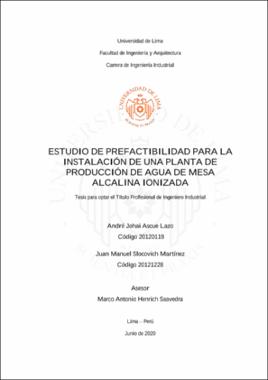Estudio de prefactibilidad para la instalación de una planta de producción de agua de mesa alcalina ionizada

Ver/
Ascue_Lazo_André_Johai.pdf
(application/pdf: 3.368Mb)
(application/pdf: 3.368Mb)
Fecha
2020Asesor(es)
Metadatos
Mostrar el registro completo del ítemResumen
In order to determine the feasibility of the project, four relevant criteria were taken into account: market, location, technology and finance. Regarding the market, the demand that was calculated for the first year of the project was 1,261,753 bottles of 625 ml alkaline water (equivalent to 84,116 packs of 15 bottles of 625 ml) at a unit price of S /. 1.60. This price is offered to wholesale distributors, who will then do their own management to sell the product to final consumers. The suggested retail price for the consumer is S / 2.00. For the location, several factors were taken into account in the selection such as availability of raw material, proximity to the target market, availability of workforce, availability of land and transport systems. After an exhaustive analysis for each factor, it was concluded that the most suitable place was Lurin. Regarding technology, there are no limitations for the present project, since both machinery and equipment belonging to the process can be acquired easily. On the other hand, the process that represents the main bottle neck is ionization, with a production capacity of 1,693,037 bottles per year. Finally, from the financial point of view, the total initial investment of the project is S/ 2,652,831.90 and is divided into 70% shareholder’s capital (S/ 1,856,982) and 30% bank financing (S/ 795,849). For this, the financing granted in the market of small and medium companies was investigated; and a loan was obtained with the Banco de Crédito del Perú with an annual effective rate of 15%. Para poder determinar la viabilidad del proyecto, se tomaron en cuenta cuatro criterios relevantes: mercado, localización, tecnología y finanzas.
En lo relacionado al mercado, la demanda que se calculó para el primer año del proyecto fue de 1,261,753 botellas de agua alcalina de 625 ml (equivalente a 84,116 packs de 15 botellas de 625 ml) a un precio unitario de S/ 1.60. Este precio se ofrece a los distribuidores mayoristas, que luego harán su propia gestión para vender el producto a los consumidores finales. El precio de venta sugerido para el consumidor es de S/ 2.00.
Para la localización, se tomaron en cuenta varios factores en la selección como disponibilidad de materia prima, cercanía al mercado objetivo, disponibilidad de mano de obra, disponibilidad de terrenos y sistemas de transporte. Luego de realizar un análisis exhaustivo por cada factor, se llegó a concluir que el lugar más adecuado era Lurín.
Existe la tecnología adecuada para llevar a cabo el proyecto, ya que tanto maquinaria como equipos que pertenecen al proceso pueden ser adquiridas con facilidad. Por otra parte, el proceso que representa el principal cuello de botella es el de ionización, con una capacidad de producción de 1,693,037 botellas por año.
Finalmente, en lo referido al análisis de finanzas, la inversión inicial total del proyecto asciende a S/ 2,652,831.90 y la estructura es de 70% capital propio (S/ 1,856,982) y 30% financiamiento bancario (S/ 795,849). Para este, se investigó los financiamientos que se otorgan en el mercado empresarial; y se obtuvo un préstamo con el Banco de Crédito del Perú con una T.E.A de 15%.
Cómo citar
Ascue Lazo, A. J. y Slocovich Martínez, J. M. (2020). Estudio de prefactibilidad para la instalación de una planta de producción de agua de mesa alcalina ionizada (tesis para optar el título profesional de Ingeniero Industrial). Universidad de Lima.Editor
Universidad de LimaTipo de obra
TesisColeccion(es)
- Tesis [1167]
El ítem tiene asociados los siguientes ficheros de licencia:

